Portfolio Management Report: Analysis of Starbucks' Portfolio
VerifiedAdded on 2020/05/08
|11
|2522
|307
Report
AI Summary
This report delves into the principles of portfolio management, emphasizing project selection and prioritization, with a specific focus on Starbucks. It highlights the importance of aligning projects with business strategies and the need for effective resource allocation. The report covers various aspects of portfolio management, including risk identification (political and technological), the application of strategic models like the strategic bucket model and process model, and the use of the BCG matrix to analyze Starbucks' product portfolio. The analysis examines how Starbucks manages its diverse product offerings (coffee, tea, mugs, etc.) within the BCG matrix framework, assessing their market positions and recommending strategic adjustments. The report also discusses the resources essential for portfolio management, such as financial and human resources, and the impact of external risks. The conclusion summarizes the key findings and underscores the significance of strategic portfolio management for business success. The report utilizes literature review and case study to illustrate the concepts of portfolio management.
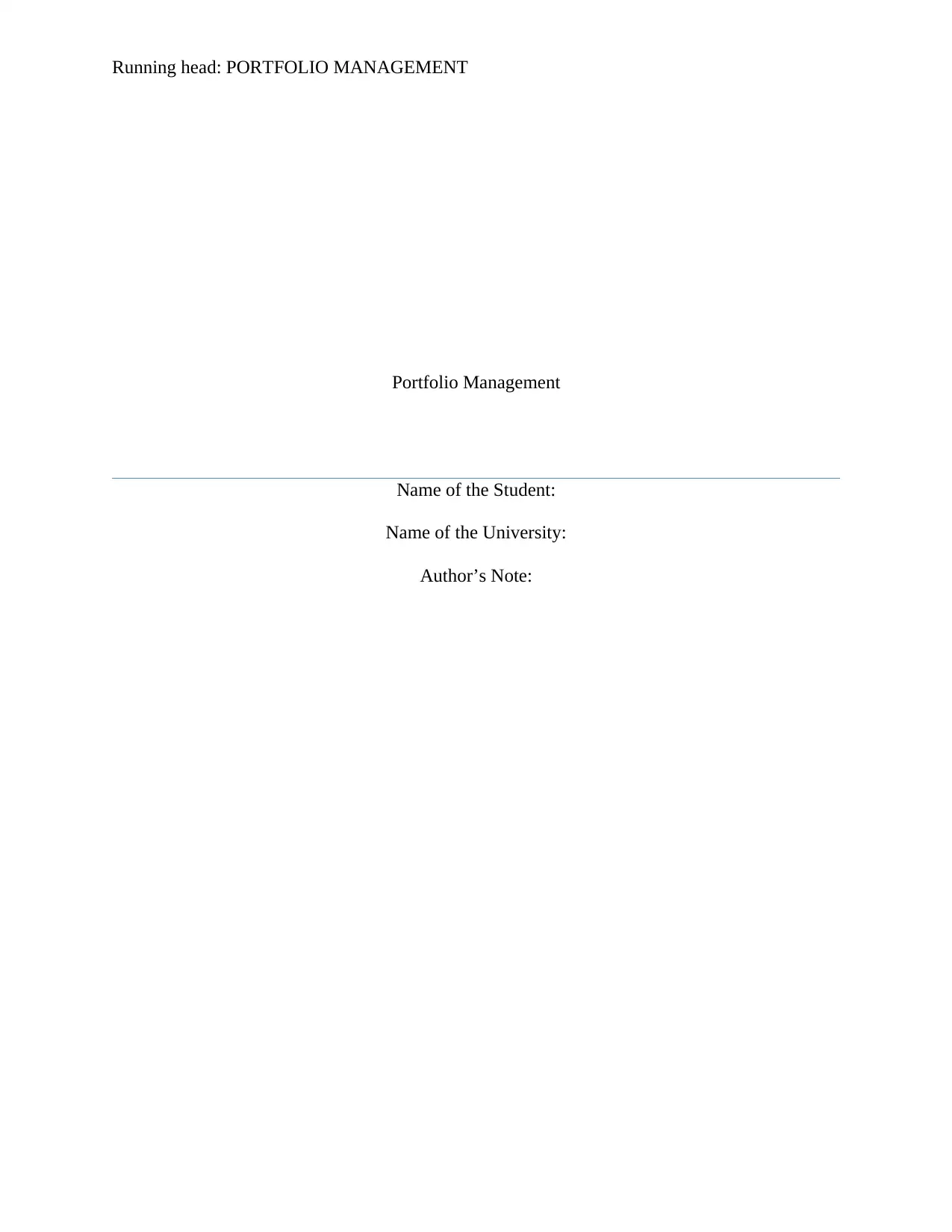
Running head: PORTFOLIO MANAGEMENT
Portfolio Management
Name of the Student:
Name of the University:
Author’s Note:
Portfolio Management
Name of the Student:
Name of the University:
Author’s Note:
Paraphrase This Document
Need a fresh take? Get an instant paraphrase of this document with our AI Paraphraser
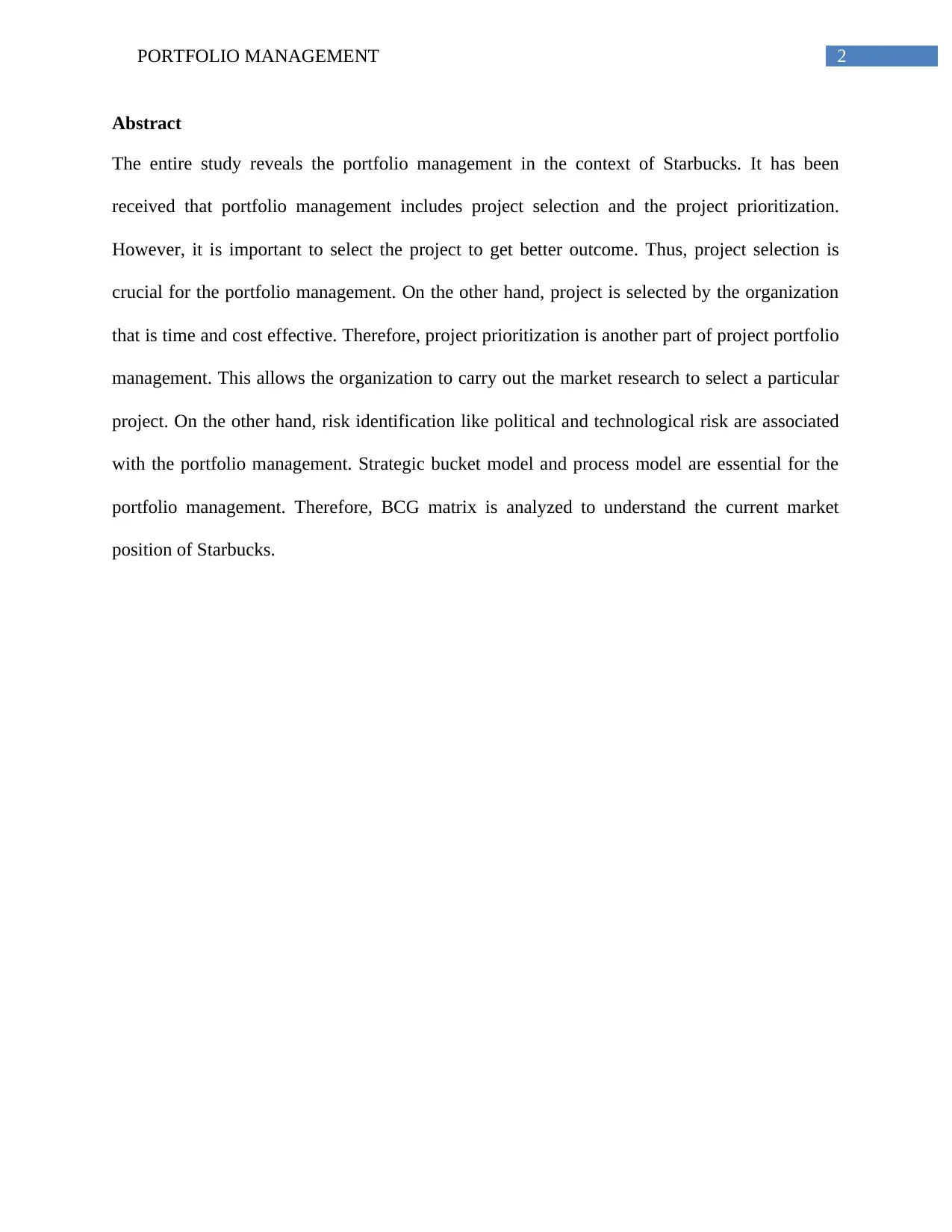
2PORTFOLIO MANAGEMENT
Abstract
The entire study reveals the portfolio management in the context of Starbucks. It has been
received that portfolio management includes project selection and the project prioritization.
However, it is important to select the project to get better outcome. Thus, project selection is
crucial for the portfolio management. On the other hand, project is selected by the organization
that is time and cost effective. Therefore, project prioritization is another part of project portfolio
management. This allows the organization to carry out the market research to select a particular
project. On the other hand, risk identification like political and technological risk are associated
with the portfolio management. Strategic bucket model and process model are essential for the
portfolio management. Therefore, BCG matrix is analyzed to understand the current market
position of Starbucks.
Abstract
The entire study reveals the portfolio management in the context of Starbucks. It has been
received that portfolio management includes project selection and the project prioritization.
However, it is important to select the project to get better outcome. Thus, project selection is
crucial for the portfolio management. On the other hand, project is selected by the organization
that is time and cost effective. Therefore, project prioritization is another part of project portfolio
management. This allows the organization to carry out the market research to select a particular
project. On the other hand, risk identification like political and technological risk are associated
with the portfolio management. Strategic bucket model and process model are essential for the
portfolio management. Therefore, BCG matrix is analyzed to understand the current market
position of Starbucks.
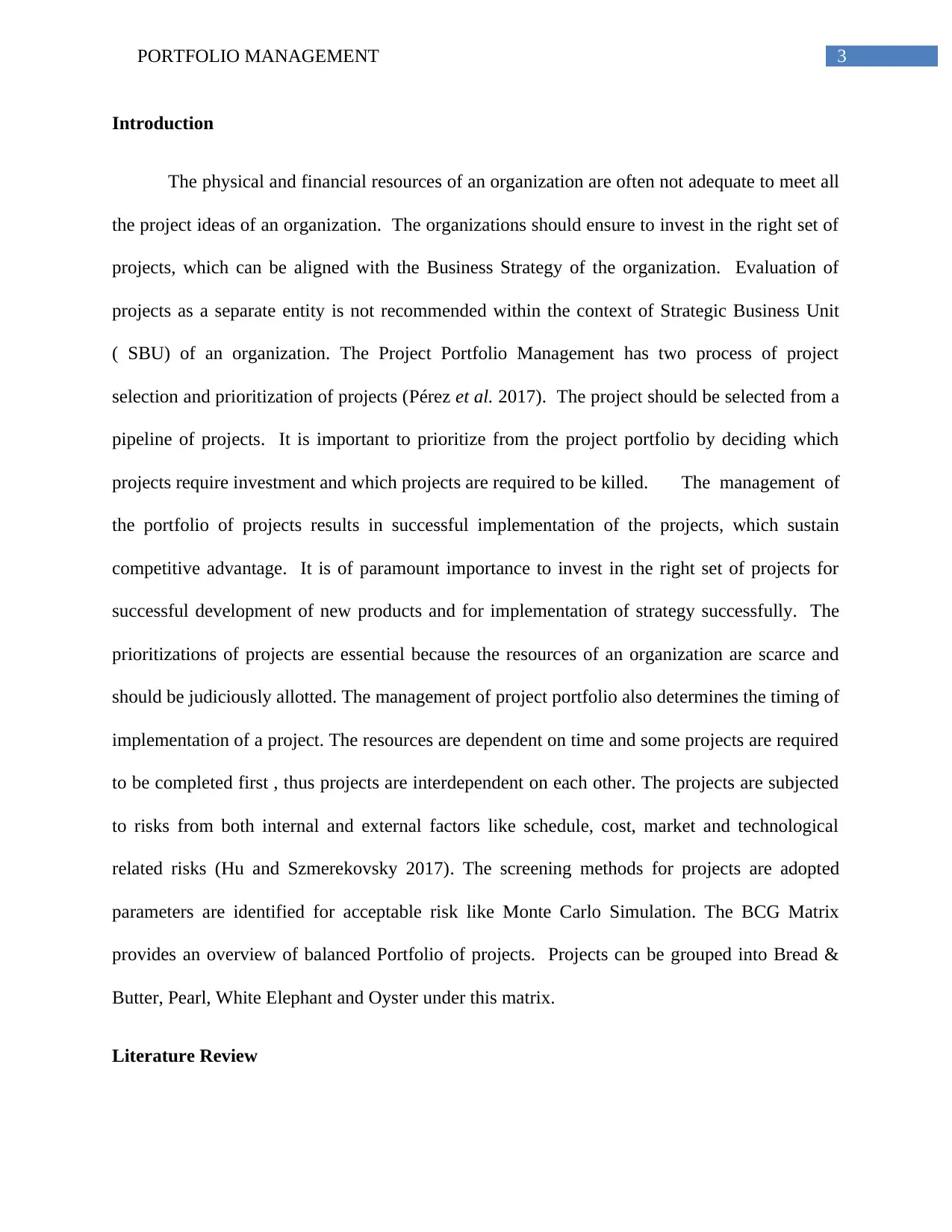
3PORTFOLIO MANAGEMENT
Introduction
The physical and financial resources of an organization are often not adequate to meet all
the project ideas of an organization. The organizations should ensure to invest in the right set of
projects, which can be aligned with the Business Strategy of the organization. Evaluation of
projects as a separate entity is not recommended within the context of Strategic Business Unit
( SBU) of an organization. The Project Portfolio Management has two process of project
selection and prioritization of projects (Pérez et al. 2017). The project should be selected from a
pipeline of projects. It is important to prioritize from the project portfolio by deciding which
projects require investment and which projects are required to be killed. The management of
the portfolio of projects results in successful implementation of the projects, which sustain
competitive advantage. It is of paramount importance to invest in the right set of projects for
successful development of new products and for implementation of strategy successfully. The
prioritizations of projects are essential because the resources of an organization are scarce and
should be judiciously allotted. The management of project portfolio also determines the timing of
implementation of a project. The resources are dependent on time and some projects are required
to be completed first , thus projects are interdependent on each other. The projects are subjected
to risks from both internal and external factors like schedule, cost, market and technological
related risks (Hu and Szmerekovsky 2017). The screening methods for projects are adopted
parameters are identified for acceptable risk like Monte Carlo Simulation. The BCG Matrix
provides an overview of balanced Portfolio of projects. Projects can be grouped into Bread &
Butter, Pearl, White Elephant and Oyster under this matrix.
Literature Review
Introduction
The physical and financial resources of an organization are often not adequate to meet all
the project ideas of an organization. The organizations should ensure to invest in the right set of
projects, which can be aligned with the Business Strategy of the organization. Evaluation of
projects as a separate entity is not recommended within the context of Strategic Business Unit
( SBU) of an organization. The Project Portfolio Management has two process of project
selection and prioritization of projects (Pérez et al. 2017). The project should be selected from a
pipeline of projects. It is important to prioritize from the project portfolio by deciding which
projects require investment and which projects are required to be killed. The management of
the portfolio of projects results in successful implementation of the projects, which sustain
competitive advantage. It is of paramount importance to invest in the right set of projects for
successful development of new products and for implementation of strategy successfully. The
prioritizations of projects are essential because the resources of an organization are scarce and
should be judiciously allotted. The management of project portfolio also determines the timing of
implementation of a project. The resources are dependent on time and some projects are required
to be completed first , thus projects are interdependent on each other. The projects are subjected
to risks from both internal and external factors like schedule, cost, market and technological
related risks (Hu and Szmerekovsky 2017). The screening methods for projects are adopted
parameters are identified for acceptable risk like Monte Carlo Simulation. The BCG Matrix
provides an overview of balanced Portfolio of projects. Projects can be grouped into Bread &
Butter, Pearl, White Elephant and Oyster under this matrix.
Literature Review
⊘ This is a preview!⊘
Do you want full access?
Subscribe today to unlock all pages.

Trusted by 1+ million students worldwide
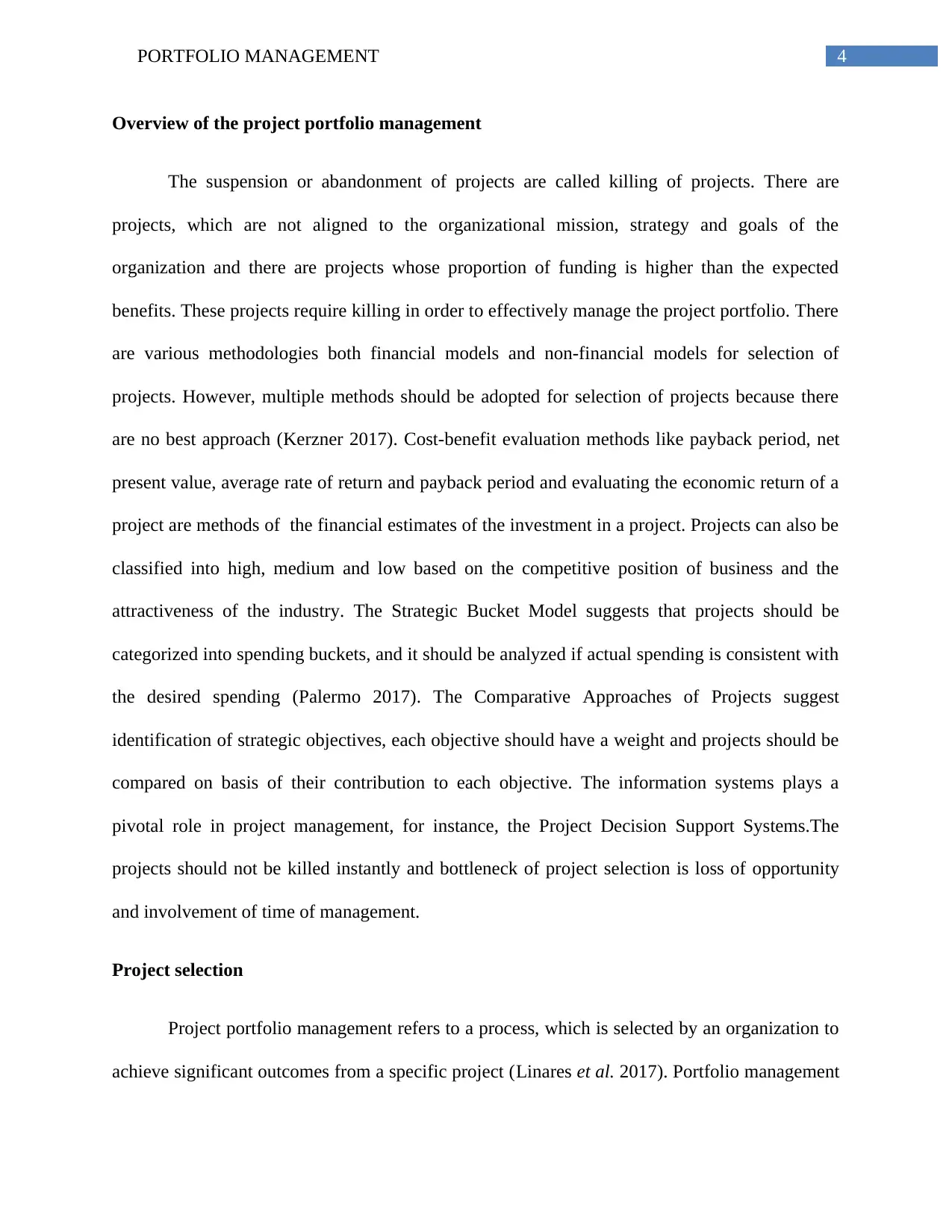
4PORTFOLIO MANAGEMENT
Overview of the project portfolio management
The suspension or abandonment of projects are called killing of projects. There are
projects, which are not aligned to the organizational mission, strategy and goals of the
organization and there are projects whose proportion of funding is higher than the expected
benefits. These projects require killing in order to effectively manage the project portfolio. There
are various methodologies both financial models and non-financial models for selection of
projects. However, multiple methods should be adopted for selection of projects because there
are no best approach (Kerzner 2017). Cost-benefit evaluation methods like payback period, net
present value, average rate of return and payback period and evaluating the economic return of a
project are methods of the financial estimates of the investment in a project. Projects can also be
classified into high, medium and low based on the competitive position of business and the
attractiveness of the industry. The Strategic Bucket Model suggests that projects should be
categorized into spending buckets, and it should be analyzed if actual spending is consistent with
the desired spending (Palermo 2017). The Comparative Approaches of Projects suggest
identification of strategic objectives, each objective should have a weight and projects should be
compared on basis of their contribution to each objective. The information systems plays a
pivotal role in project management, for instance, the Project Decision Support Systems.The
projects should not be killed instantly and bottleneck of project selection is loss of opportunity
and involvement of time of management.
Project selection
Project portfolio management refers to a process, which is selected by an organization to
achieve significant outcomes from a specific project (Linares et al. 2017). Portfolio management
Overview of the project portfolio management
The suspension or abandonment of projects are called killing of projects. There are
projects, which are not aligned to the organizational mission, strategy and goals of the
organization and there are projects whose proportion of funding is higher than the expected
benefits. These projects require killing in order to effectively manage the project portfolio. There
are various methodologies both financial models and non-financial models for selection of
projects. However, multiple methods should be adopted for selection of projects because there
are no best approach (Kerzner 2017). Cost-benefit evaluation methods like payback period, net
present value, average rate of return and payback period and evaluating the economic return of a
project are methods of the financial estimates of the investment in a project. Projects can also be
classified into high, medium and low based on the competitive position of business and the
attractiveness of the industry. The Strategic Bucket Model suggests that projects should be
categorized into spending buckets, and it should be analyzed if actual spending is consistent with
the desired spending (Palermo 2017). The Comparative Approaches of Projects suggest
identification of strategic objectives, each objective should have a weight and projects should be
compared on basis of their contribution to each objective. The information systems plays a
pivotal role in project management, for instance, the Project Decision Support Systems.The
projects should not be killed instantly and bottleneck of project selection is loss of opportunity
and involvement of time of management.
Project selection
Project portfolio management refers to a process, which is selected by an organization to
achieve significant outcomes from a specific project (Linares et al. 2017). Portfolio management
Paraphrase This Document
Need a fresh take? Get an instant paraphrase of this document with our AI Paraphraser
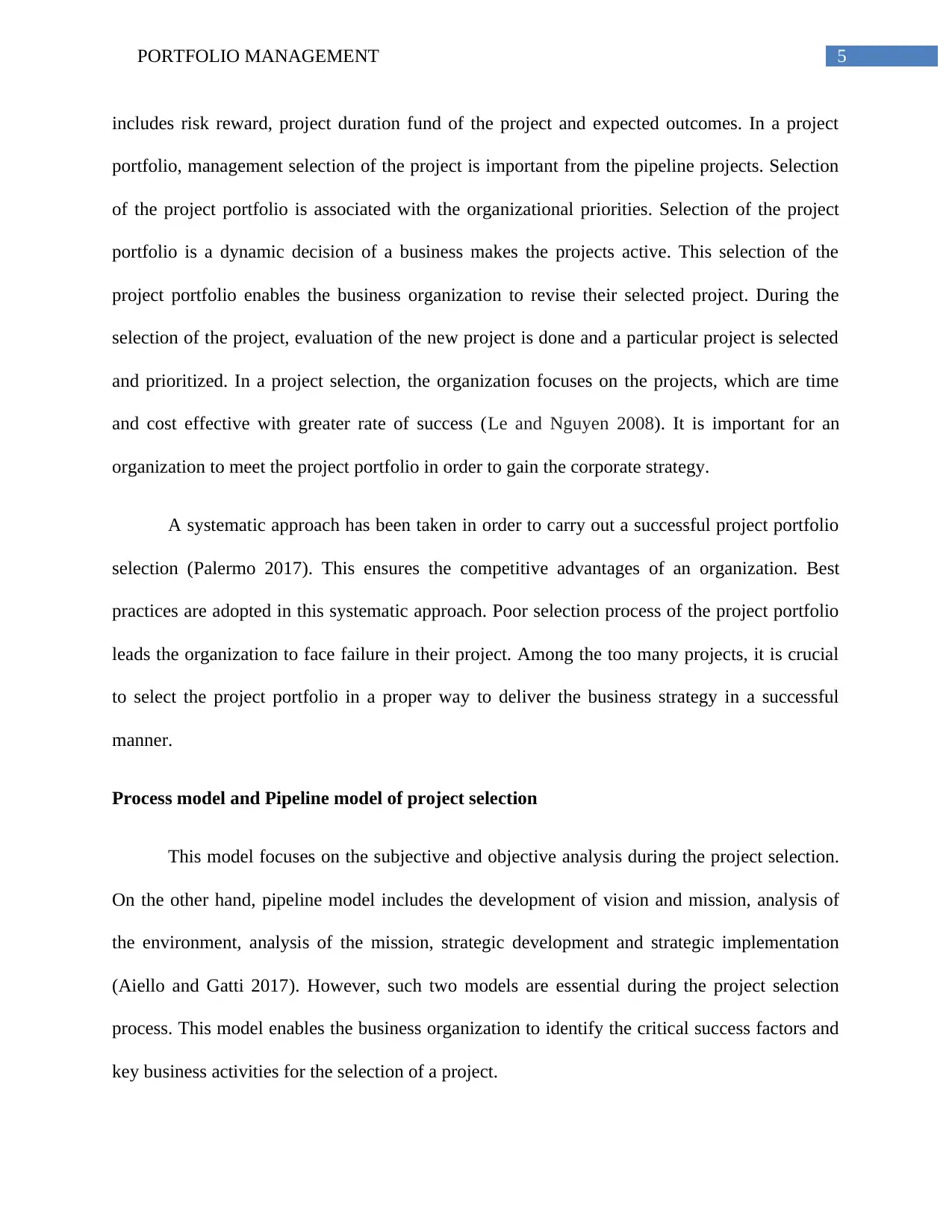
5PORTFOLIO MANAGEMENT
includes risk reward, project duration fund of the project and expected outcomes. In a project
portfolio, management selection of the project is important from the pipeline projects. Selection
of the project portfolio is associated with the organizational priorities. Selection of the project
portfolio is a dynamic decision of a business makes the projects active. This selection of the
project portfolio enables the business organization to revise their selected project. During the
selection of the project, evaluation of the new project is done and a particular project is selected
and prioritized. In a project selection, the organization focuses on the projects, which are time
and cost effective with greater rate of success (Le and Nguyen 2008). It is important for an
organization to meet the project portfolio in order to gain the corporate strategy.
A systematic approach has been taken in order to carry out a successful project portfolio
selection (Palermo 2017). This ensures the competitive advantages of an organization. Best
practices are adopted in this systematic approach. Poor selection process of the project portfolio
leads the organization to face failure in their project. Among the too many projects, it is crucial
to select the project portfolio in a proper way to deliver the business strategy in a successful
manner.
Process model and Pipeline model of project selection
This model focuses on the subjective and objective analysis during the project selection.
On the other hand, pipeline model includes the development of vision and mission, analysis of
the environment, analysis of the mission, strategic development and strategic implementation
(Aiello and Gatti 2017). However, such two models are essential during the project selection
process. This model enables the business organization to identify the critical success factors and
key business activities for the selection of a project.
includes risk reward, project duration fund of the project and expected outcomes. In a project
portfolio, management selection of the project is important from the pipeline projects. Selection
of the project portfolio is associated with the organizational priorities. Selection of the project
portfolio is a dynamic decision of a business makes the projects active. This selection of the
project portfolio enables the business organization to revise their selected project. During the
selection of the project, evaluation of the new project is done and a particular project is selected
and prioritized. In a project selection, the organization focuses on the projects, which are time
and cost effective with greater rate of success (Le and Nguyen 2008). It is important for an
organization to meet the project portfolio in order to gain the corporate strategy.
A systematic approach has been taken in order to carry out a successful project portfolio
selection (Palermo 2017). This ensures the competitive advantages of an organization. Best
practices are adopted in this systematic approach. Poor selection process of the project portfolio
leads the organization to face failure in their project. Among the too many projects, it is crucial
to select the project portfolio in a proper way to deliver the business strategy in a successful
manner.
Process model and Pipeline model of project selection
This model focuses on the subjective and objective analysis during the project selection.
On the other hand, pipeline model includes the development of vision and mission, analysis of
the environment, analysis of the mission, strategic development and strategic implementation
(Aiello and Gatti 2017). However, such two models are essential during the project selection
process. This model enables the business organization to identify the critical success factors and
key business activities for the selection of a project.
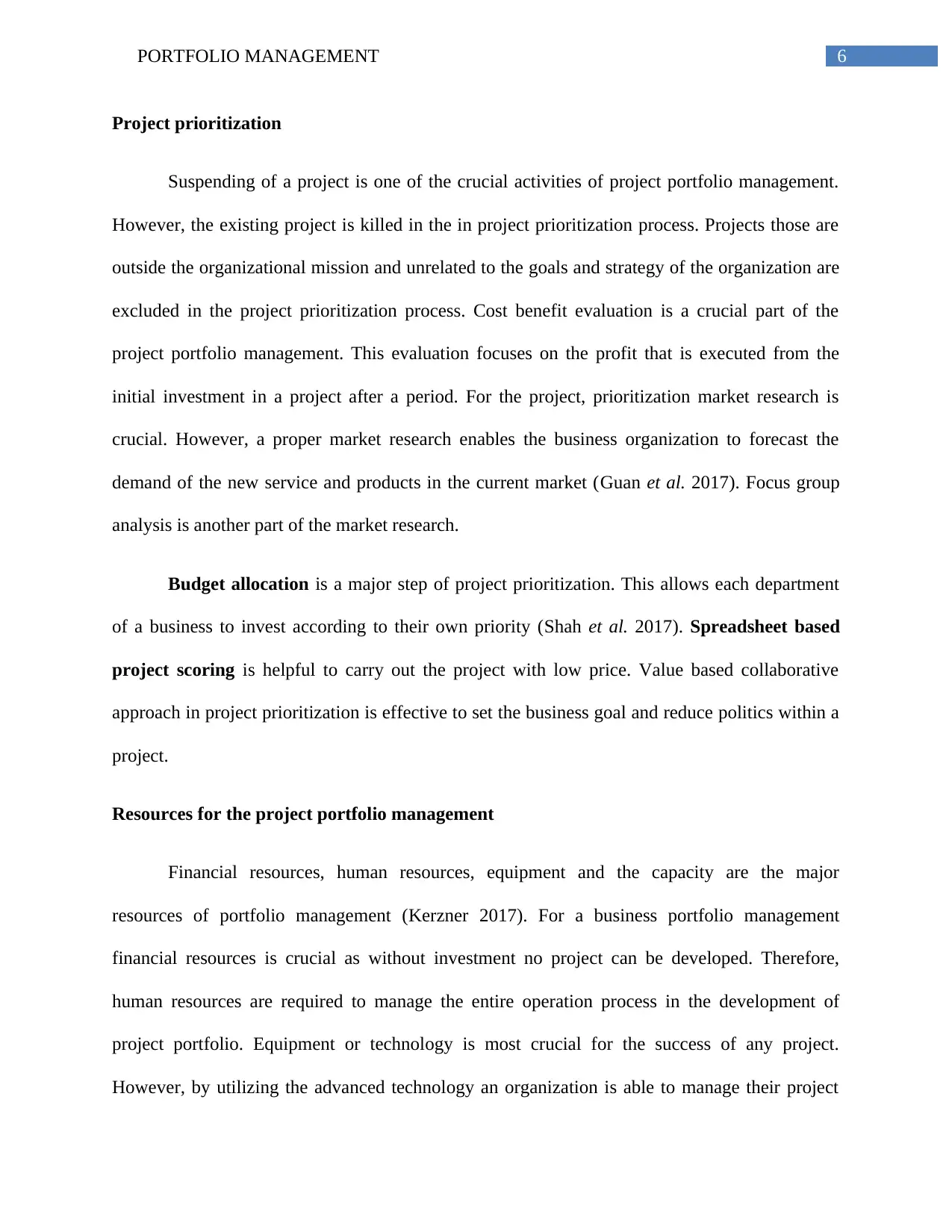
6PORTFOLIO MANAGEMENT
Project prioritization
Suspending of a project is one of the crucial activities of project portfolio management.
However, the existing project is killed in the in project prioritization process. Projects those are
outside the organizational mission and unrelated to the goals and strategy of the organization are
excluded in the project prioritization process. Cost benefit evaluation is a crucial part of the
project portfolio management. This evaluation focuses on the profit that is executed from the
initial investment in a project after a period. For the project, prioritization market research is
crucial. However, a proper market research enables the business organization to forecast the
demand of the new service and products in the current market (Guan et al. 2017). Focus group
analysis is another part of the market research.
Budget allocation is a major step of project prioritization. This allows each department
of a business to invest according to their own priority (Shah et al. 2017). Spreadsheet based
project scoring is helpful to carry out the project with low price. Value based collaborative
approach in project prioritization is effective to set the business goal and reduce politics within a
project.
Resources for the project portfolio management
Financial resources, human resources, equipment and the capacity are the major
resources of portfolio management (Kerzner 2017). For a business portfolio management
financial resources is crucial as without investment no project can be developed. Therefore,
human resources are required to manage the entire operation process in the development of
project portfolio. Equipment or technology is most crucial for the success of any project.
However, by utilizing the advanced technology an organization is able to manage their project
Project prioritization
Suspending of a project is one of the crucial activities of project portfolio management.
However, the existing project is killed in the in project prioritization process. Projects those are
outside the organizational mission and unrelated to the goals and strategy of the organization are
excluded in the project prioritization process. Cost benefit evaluation is a crucial part of the
project portfolio management. This evaluation focuses on the profit that is executed from the
initial investment in a project after a period. For the project, prioritization market research is
crucial. However, a proper market research enables the business organization to forecast the
demand of the new service and products in the current market (Guan et al. 2017). Focus group
analysis is another part of the market research.
Budget allocation is a major step of project prioritization. This allows each department
of a business to invest according to their own priority (Shah et al. 2017). Spreadsheet based
project scoring is helpful to carry out the project with low price. Value based collaborative
approach in project prioritization is effective to set the business goal and reduce politics within a
project.
Resources for the project portfolio management
Financial resources, human resources, equipment and the capacity are the major
resources of portfolio management (Kerzner 2017). For a business portfolio management
financial resources is crucial as without investment no project can be developed. Therefore,
human resources are required to manage the entire operation process in the development of
project portfolio. Equipment or technology is most crucial for the success of any project.
However, by utilizing the advanced technology an organization is able to manage their project
⊘ This is a preview!⊘
Do you want full access?
Subscribe today to unlock all pages.

Trusted by 1+ million students worldwide
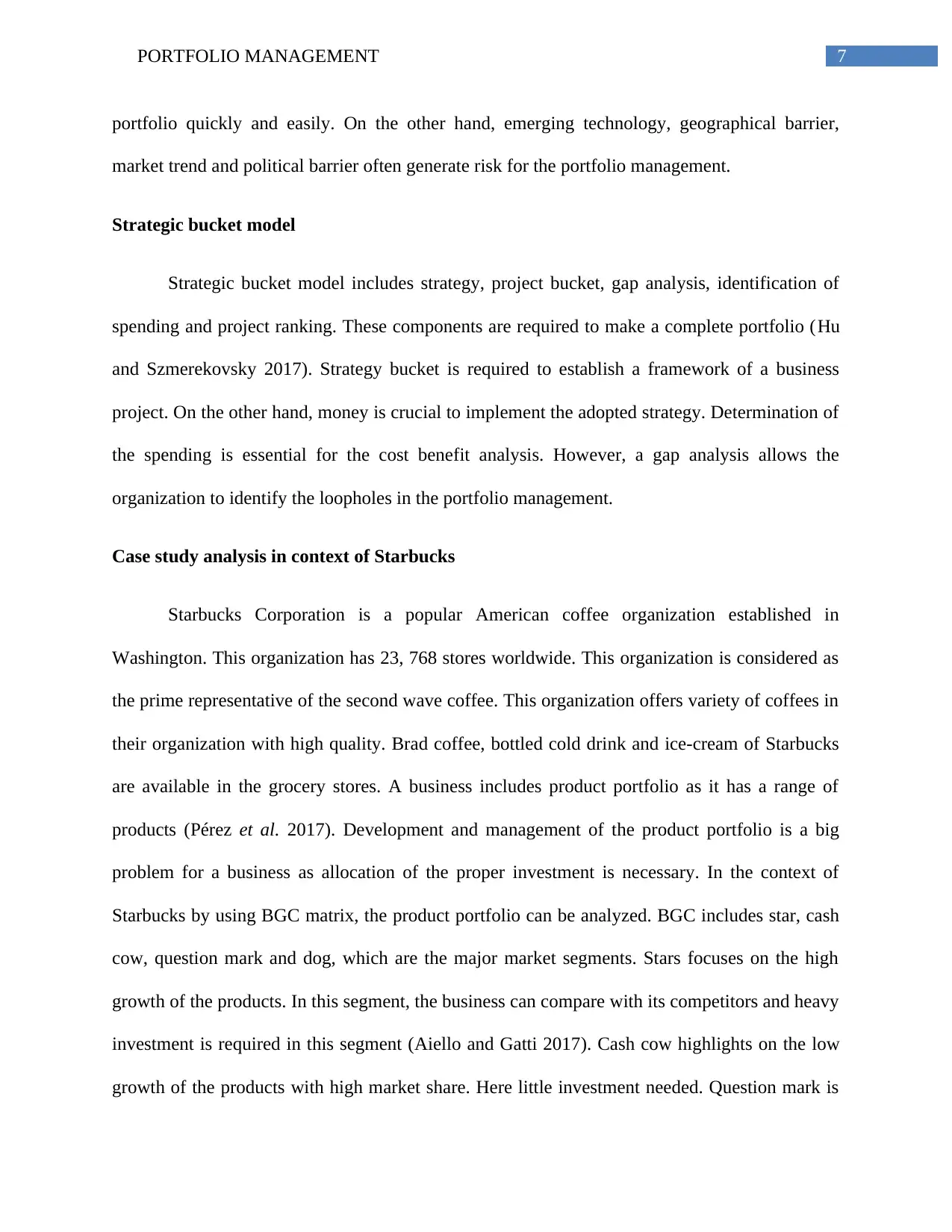
7PORTFOLIO MANAGEMENT
portfolio quickly and easily. On the other hand, emerging technology, geographical barrier,
market trend and political barrier often generate risk for the portfolio management.
Strategic bucket model
Strategic bucket model includes strategy, project bucket, gap analysis, identification of
spending and project ranking. These components are required to make a complete portfolio (Hu
and Szmerekovsky 2017). Strategy bucket is required to establish a framework of a business
project. On the other hand, money is crucial to implement the adopted strategy. Determination of
the spending is essential for the cost benefit analysis. However, a gap analysis allows the
organization to identify the loopholes in the portfolio management.
Case study analysis in context of Starbucks
Starbucks Corporation is a popular American coffee organization established in
Washington. This organization has 23, 768 stores worldwide. This organization is considered as
the prime representative of the second wave coffee. This organization offers variety of coffees in
their organization with high quality. Brad coffee, bottled cold drink and ice-cream of Starbucks
are available in the grocery stores. A business includes product portfolio as it has a range of
products (Pérez et al. 2017). Development and management of the product portfolio is a big
problem for a business as allocation of the proper investment is necessary. In the context of
Starbucks by using BGC matrix, the product portfolio can be analyzed. BGC includes star, cash
cow, question mark and dog, which are the major market segments. Stars focuses on the high
growth of the products. In this segment, the business can compare with its competitors and heavy
investment is required in this segment (Aiello and Gatti 2017). Cash cow highlights on the low
growth of the products with high market share. Here little investment needed. Question mark is
portfolio quickly and easily. On the other hand, emerging technology, geographical barrier,
market trend and political barrier often generate risk for the portfolio management.
Strategic bucket model
Strategic bucket model includes strategy, project bucket, gap analysis, identification of
spending and project ranking. These components are required to make a complete portfolio (Hu
and Szmerekovsky 2017). Strategy bucket is required to establish a framework of a business
project. On the other hand, money is crucial to implement the adopted strategy. Determination of
the spending is essential for the cost benefit analysis. However, a gap analysis allows the
organization to identify the loopholes in the portfolio management.
Case study analysis in context of Starbucks
Starbucks Corporation is a popular American coffee organization established in
Washington. This organization has 23, 768 stores worldwide. This organization is considered as
the prime representative of the second wave coffee. This organization offers variety of coffees in
their organization with high quality. Brad coffee, bottled cold drink and ice-cream of Starbucks
are available in the grocery stores. A business includes product portfolio as it has a range of
products (Pérez et al. 2017). Development and management of the product portfolio is a big
problem for a business as allocation of the proper investment is necessary. In the context of
Starbucks by using BGC matrix, the product portfolio can be analyzed. BGC includes star, cash
cow, question mark and dog, which are the major market segments. Stars focuses on the high
growth of the products. In this segment, the business can compare with its competitors and heavy
investment is required in this segment (Aiello and Gatti 2017). Cash cow highlights on the low
growth of the products with high market share. Here little investment needed. Question mark is
Paraphrase This Document
Need a fresh take? Get an instant paraphrase of this document with our AI Paraphraser
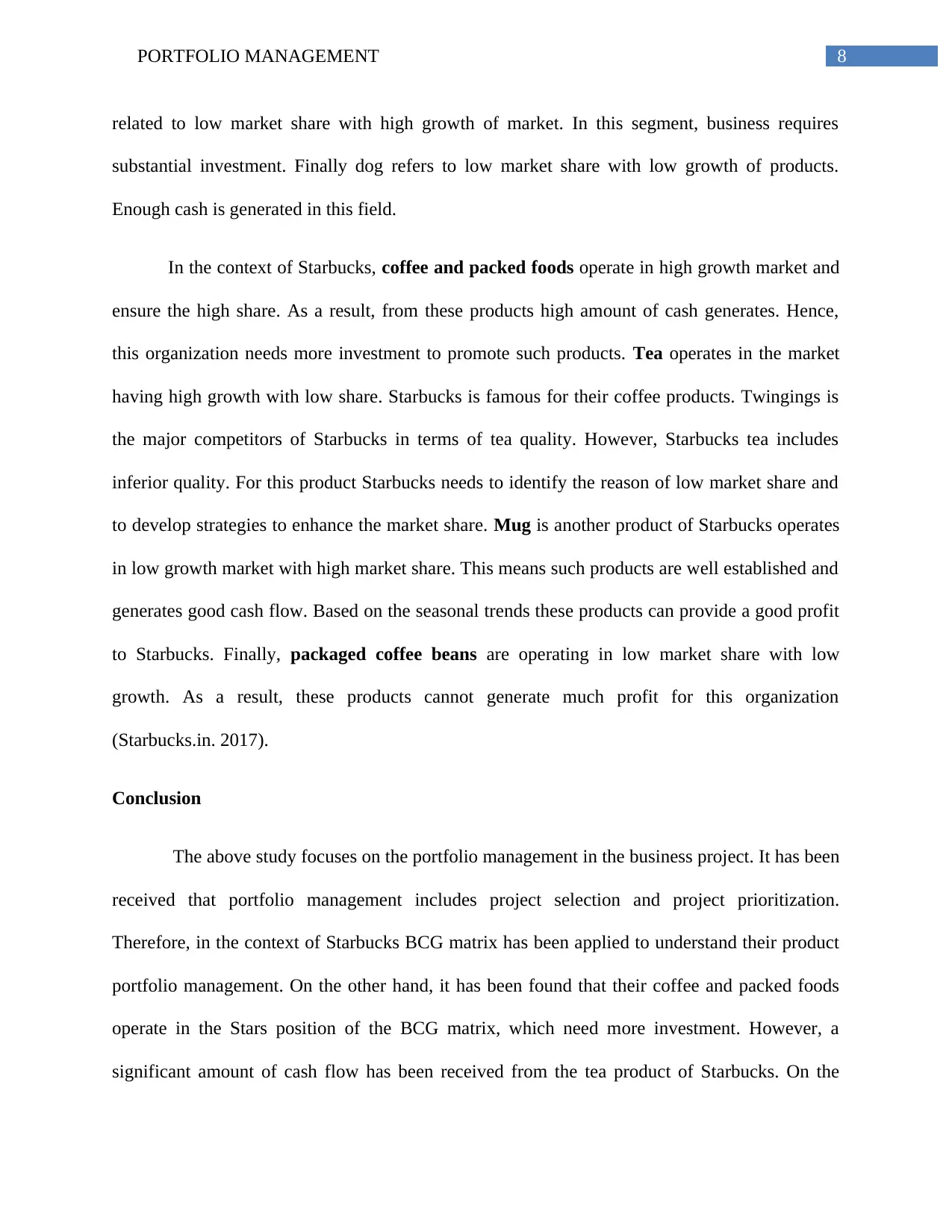
8PORTFOLIO MANAGEMENT
related to low market share with high growth of market. In this segment, business requires
substantial investment. Finally dog refers to low market share with low growth of products.
Enough cash is generated in this field.
In the context of Starbucks, coffee and packed foods operate in high growth market and
ensure the high share. As a result, from these products high amount of cash generates. Hence,
this organization needs more investment to promote such products. Tea operates in the market
having high growth with low share. Starbucks is famous for their coffee products. Twingings is
the major competitors of Starbucks in terms of tea quality. However, Starbucks tea includes
inferior quality. For this product Starbucks needs to identify the reason of low market share and
to develop strategies to enhance the market share. Mug is another product of Starbucks operates
in low growth market with high market share. This means such products are well established and
generates good cash flow. Based on the seasonal trends these products can provide a good profit
to Starbucks. Finally, packaged coffee beans are operating in low market share with low
growth. As a result, these products cannot generate much profit for this organization
(Starbucks.in. 2017).
Conclusion
The above study focuses on the portfolio management in the business project. It has been
received that portfolio management includes project selection and project prioritization.
Therefore, in the context of Starbucks BCG matrix has been applied to understand their product
portfolio management. On the other hand, it has been found that their coffee and packed foods
operate in the Stars position of the BCG matrix, which need more investment. However, a
significant amount of cash flow has been received from the tea product of Starbucks. On the
related to low market share with high growth of market. In this segment, business requires
substantial investment. Finally dog refers to low market share with low growth of products.
Enough cash is generated in this field.
In the context of Starbucks, coffee and packed foods operate in high growth market and
ensure the high share. As a result, from these products high amount of cash generates. Hence,
this organization needs more investment to promote such products. Tea operates in the market
having high growth with low share. Starbucks is famous for their coffee products. Twingings is
the major competitors of Starbucks in terms of tea quality. However, Starbucks tea includes
inferior quality. For this product Starbucks needs to identify the reason of low market share and
to develop strategies to enhance the market share. Mug is another product of Starbucks operates
in low growth market with high market share. This means such products are well established and
generates good cash flow. Based on the seasonal trends these products can provide a good profit
to Starbucks. Finally, packaged coffee beans are operating in low market share with low
growth. As a result, these products cannot generate much profit for this organization
(Starbucks.in. 2017).
Conclusion
The above study focuses on the portfolio management in the business project. It has been
received that portfolio management includes project selection and project prioritization.
Therefore, in the context of Starbucks BCG matrix has been applied to understand their product
portfolio management. On the other hand, it has been found that their coffee and packed foods
operate in the Stars position of the BCG matrix, which need more investment. However, a
significant amount of cash flow has been received from the tea product of Starbucks. On the
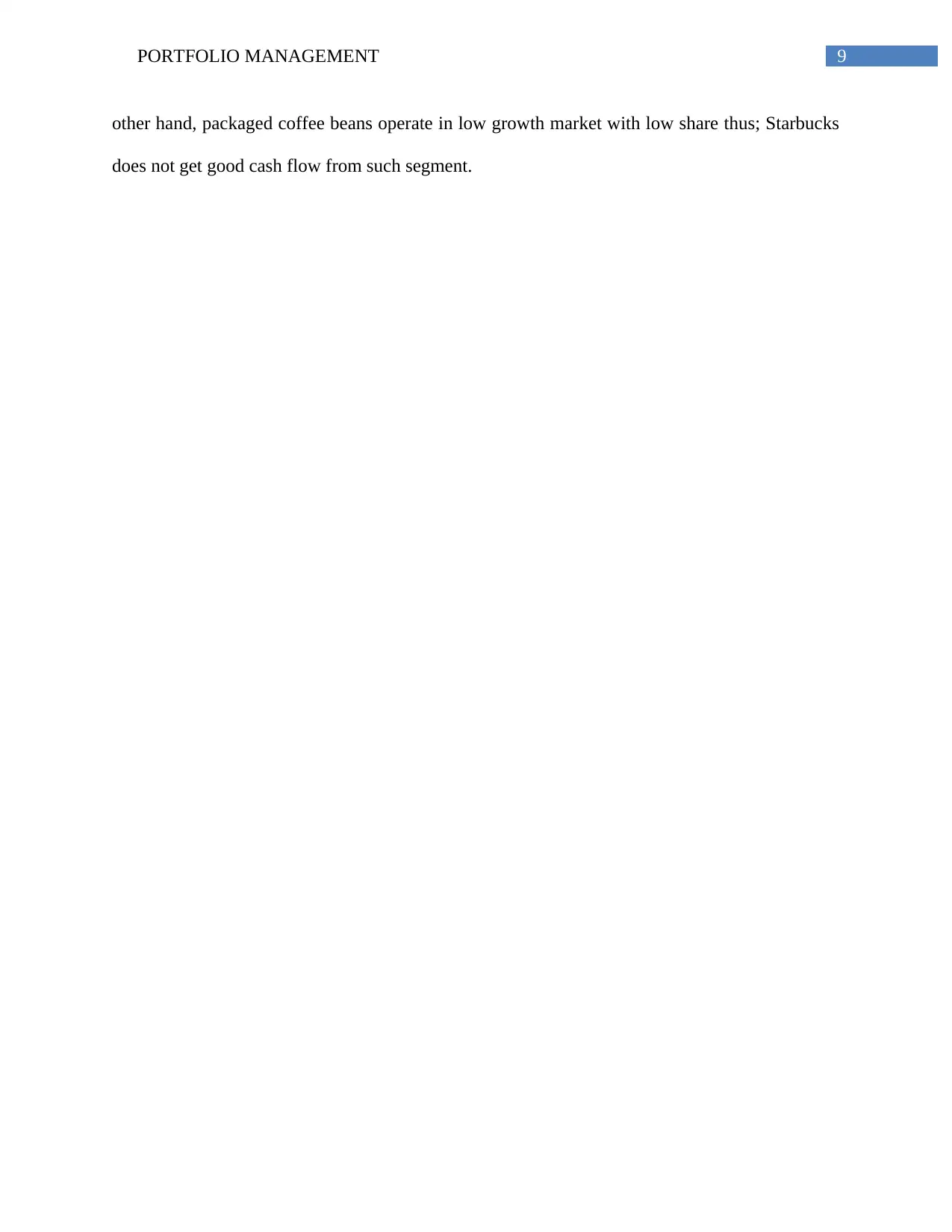
9PORTFOLIO MANAGEMENT
other hand, packaged coffee beans operate in low growth market with low share thus; Starbucks
does not get good cash flow from such segment.
other hand, packaged coffee beans operate in low growth market with low share thus; Starbucks
does not get good cash flow from such segment.
⊘ This is a preview!⊘
Do you want full access?
Subscribe today to unlock all pages.

Trusted by 1+ million students worldwide
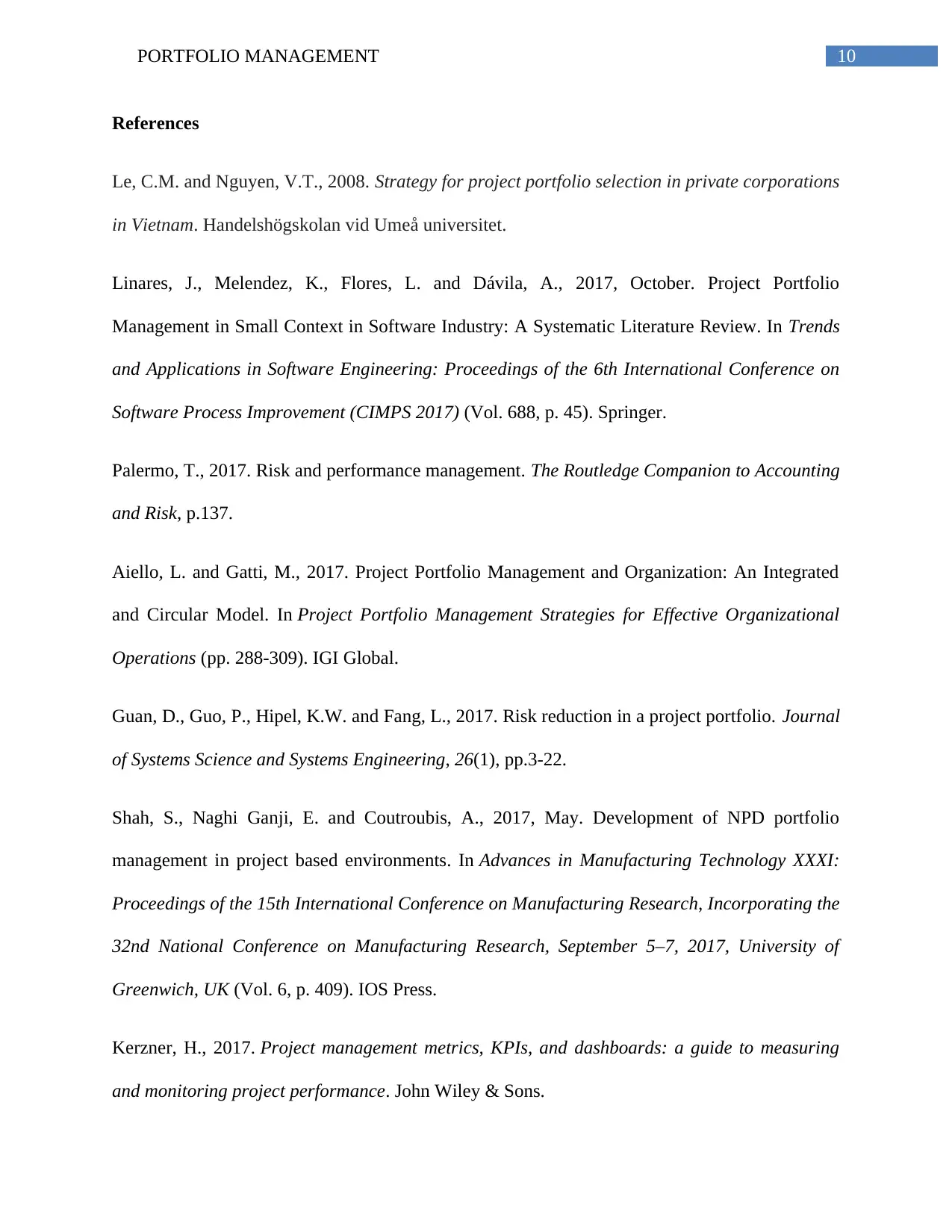
10PORTFOLIO MANAGEMENT
References
Le, C.M. and Nguyen, V.T., 2008. Strategy for project portfolio selection in private corporations
in Vietnam. Handelshögskolan vid Umeå universitet.
Linares, J., Melendez, K., Flores, L. and Dávila, A., 2017, October. Project Portfolio
Management in Small Context in Software Industry: A Systematic Literature Review. In Trends
and Applications in Software Engineering: Proceedings of the 6th International Conference on
Software Process Improvement (CIMPS 2017) (Vol. 688, p. 45). Springer.
Palermo, T., 2017. Risk and performance management. The Routledge Companion to Accounting
and Risk, p.137.
Aiello, L. and Gatti, M., 2017. Project Portfolio Management and Organization: An Integrated
and Circular Model. In Project Portfolio Management Strategies for Effective Organizational
Operations (pp. 288-309). IGI Global.
Guan, D., Guo, P., Hipel, K.W. and Fang, L., 2017. Risk reduction in a project portfolio. Journal
of Systems Science and Systems Engineering, 26(1), pp.3-22.
Shah, S., Naghi Ganji, E. and Coutroubis, A., 2017, May. Development of NPD portfolio
management in project based environments. In Advances in Manufacturing Technology XXXI:
Proceedings of the 15th International Conference on Manufacturing Research, Incorporating the
32nd National Conference on Manufacturing Research, September 5–7, 2017, University of
Greenwich, UK (Vol. 6, p. 409). IOS Press.
Kerzner, H., 2017. Project management metrics, KPIs, and dashboards: a guide to measuring
and monitoring project performance. John Wiley & Sons.
References
Le, C.M. and Nguyen, V.T., 2008. Strategy for project portfolio selection in private corporations
in Vietnam. Handelshögskolan vid Umeå universitet.
Linares, J., Melendez, K., Flores, L. and Dávila, A., 2017, October. Project Portfolio
Management in Small Context in Software Industry: A Systematic Literature Review. In Trends
and Applications in Software Engineering: Proceedings of the 6th International Conference on
Software Process Improvement (CIMPS 2017) (Vol. 688, p. 45). Springer.
Palermo, T., 2017. Risk and performance management. The Routledge Companion to Accounting
and Risk, p.137.
Aiello, L. and Gatti, M., 2017. Project Portfolio Management and Organization: An Integrated
and Circular Model. In Project Portfolio Management Strategies for Effective Organizational
Operations (pp. 288-309). IGI Global.
Guan, D., Guo, P., Hipel, K.W. and Fang, L., 2017. Risk reduction in a project portfolio. Journal
of Systems Science and Systems Engineering, 26(1), pp.3-22.
Shah, S., Naghi Ganji, E. and Coutroubis, A., 2017, May. Development of NPD portfolio
management in project based environments. In Advances in Manufacturing Technology XXXI:
Proceedings of the 15th International Conference on Manufacturing Research, Incorporating the
32nd National Conference on Manufacturing Research, September 5–7, 2017, University of
Greenwich, UK (Vol. 6, p. 409). IOS Press.
Kerzner, H., 2017. Project management metrics, KPIs, and dashboards: a guide to measuring
and monitoring project performance. John Wiley & Sons.
Paraphrase This Document
Need a fresh take? Get an instant paraphrase of this document with our AI Paraphraser
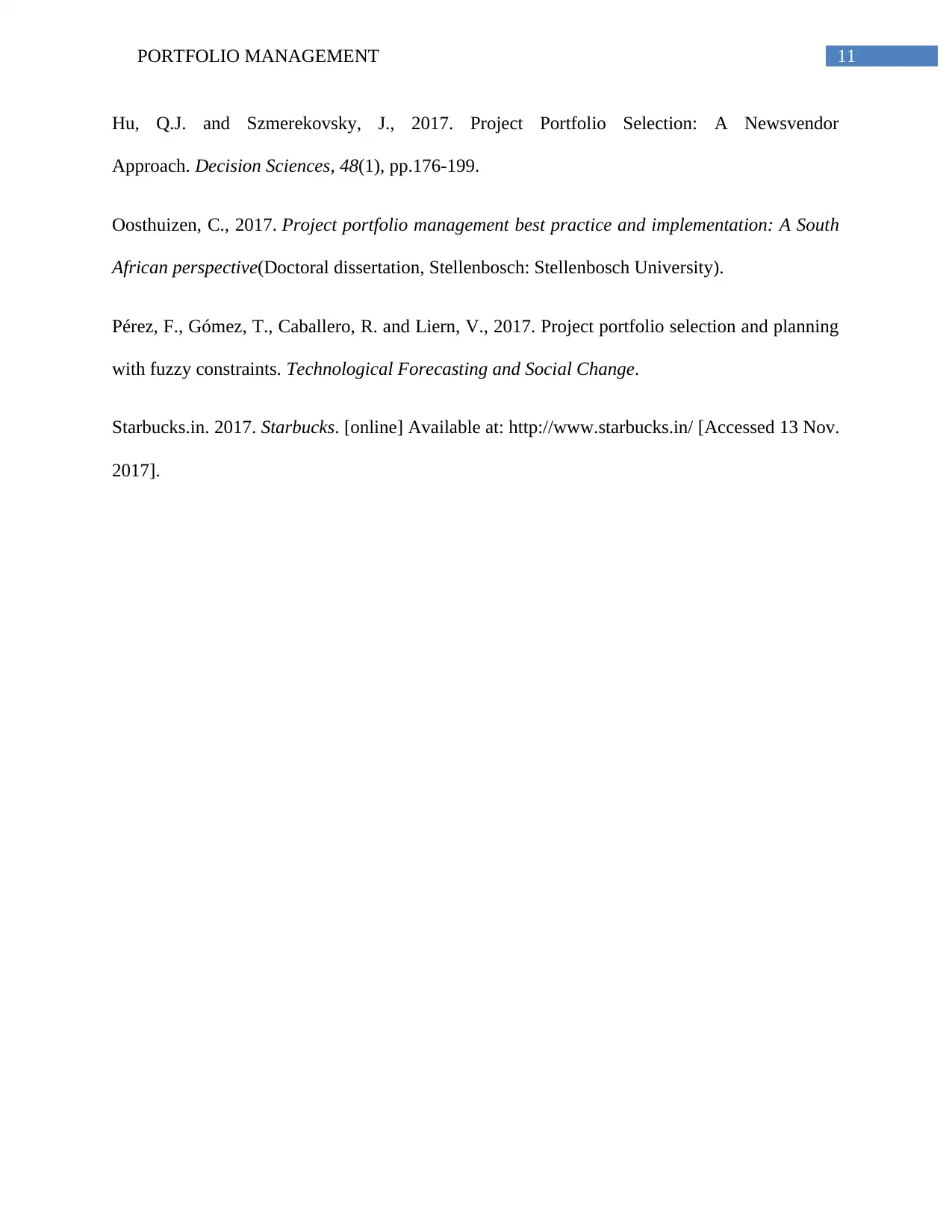
11PORTFOLIO MANAGEMENT
Hu, Q.J. and Szmerekovsky, J., 2017. Project Portfolio Selection: A Newsvendor
Approach. Decision Sciences, 48(1), pp.176-199.
Oosthuizen, C., 2017. Project portfolio management best practice and implementation: A South
African perspective(Doctoral dissertation, Stellenbosch: Stellenbosch University).
Pérez, F., Gómez, T., Caballero, R. and Liern, V., 2017. Project portfolio selection and planning
with fuzzy constraints. Technological Forecasting and Social Change.
Starbucks.in. 2017. Starbucks. [online] Available at: http://www.starbucks.in/ [Accessed 13 Nov.
2017].
Hu, Q.J. and Szmerekovsky, J., 2017. Project Portfolio Selection: A Newsvendor
Approach. Decision Sciences, 48(1), pp.176-199.
Oosthuizen, C., 2017. Project portfolio management best practice and implementation: A South
African perspective(Doctoral dissertation, Stellenbosch: Stellenbosch University).
Pérez, F., Gómez, T., Caballero, R. and Liern, V., 2017. Project portfolio selection and planning
with fuzzy constraints. Technological Forecasting and Social Change.
Starbucks.in. 2017. Starbucks. [online] Available at: http://www.starbucks.in/ [Accessed 13 Nov.
2017].
1 out of 11
Related Documents
Your All-in-One AI-Powered Toolkit for Academic Success.
+13062052269
info@desklib.com
Available 24*7 on WhatsApp / Email
![[object Object]](/_next/static/media/star-bottom.7253800d.svg)
Unlock your academic potential
Copyright © 2020–2025 A2Z Services. All Rights Reserved. Developed and managed by ZUCOL.





